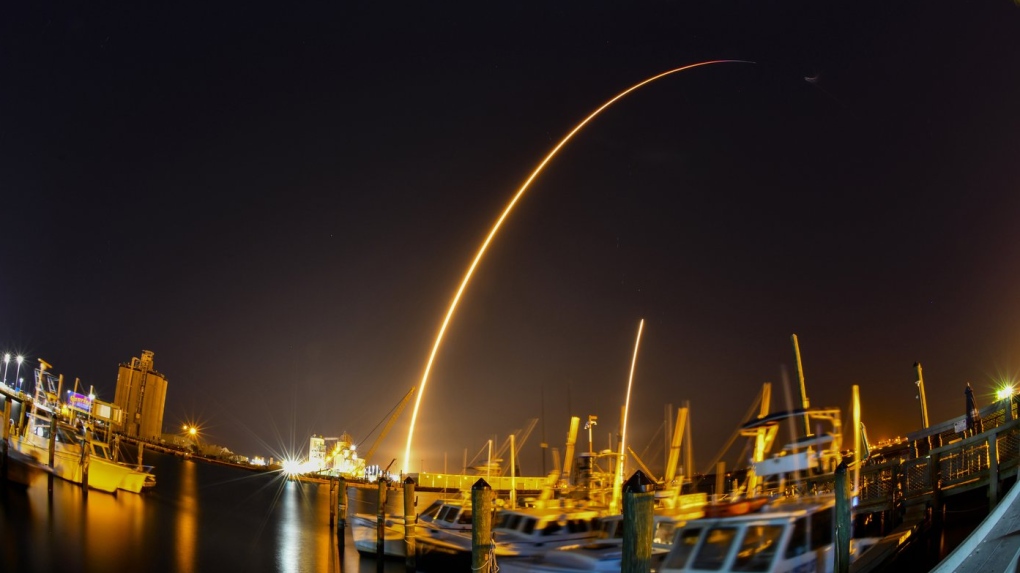CAPE CANAVERAL, Florida –
A Tokyo company aimed for the moon with its own private lander on Sunday, blasting off atop a SpaceX rocket with the United Arab Emirates’ first lunar rover and a toy-like Japanese robot designed to roll up there in the gray dust .
It will take nearly five months for the lander and its experiments to reach the moon.
The ispace company designed their craft to use minimal fuel to save money and allow more space for cargo. So it takes a slow, low-energy path to the moon, flying 1.6 million miles from Earth before looping and crossing with the moon by the end of April.
In contrast, NASA’s Orion crew capsule with test dummies took five days to reach the moon last month. The lunar flyby mission ended Sunday with a thrilling dip in the Pacific.
The ispace lander will target the Atlas crater in the northeast part of the near side of the moon, more than 87 kilometers across and just over 2 kilometers deep. With all four legs extended, the lander is over 2.3 meters tall.
With a scientific satellite already around Mars, the United Arab Emirates also wants to explore the Moon. His rover, named Rashid after the Dubai royal family, weighs just 10 kilograms and will operate on the surface for about 10 days, like the rest of the mission.
Emirates project manager Hamad AlMarzooqi said landing on an unexplored part of the moon would provide “new and much appreciated” scientific data. Moreover, the lunar surface is “an ideal platform” for testing new technologies that could be used for possible human expeditions to Mars.
Additionally, there is national pride – the rover represents “a pioneering national undertaking in the space sector and a historic moment which, if successful, will be the first Emirati and Arab mission to land on the surface of the moon”, he said in a statement. following takeoff.
Additionally, the lander carries a Japan Space Agency orange-sized sphere that will transform into a wheeled robot on the moon. Also flying: a solid-state battery from a Japan-based spark plug company; an Ottawa company’s flight computer with artificial intelligence to identify geological features seen by the UAE rover; and 360-degree cameras from a Toronto-area company.
Hitching on the rocket was a small NASA laser experiment that is now bound for the moon to chase ice in the permanently shadowed craters of the lunar south pole.
The ispace mission is called Hakuto, in Japanese meaning white rabbit. In Asian folklore, a white rabbit is said to live on the moon. A second lunar landing by the private company is scheduled for 2024 and a third in 2025.
Founded in 2010, ispace was among the finalists in the Google Lunar XPRIZE competition demanding a successful moon landing by 2018. The ispace-built lunar rover was never launched.
Another finalist, an Israeli nonprofit called SpaceIL, managed to reach the moon in 2019. But instead of landing smoothly, the Beresheet spacecraft slammed into the moon and was destroyed.
With Sunday’s predawn launch from Space Force Station Cape Canaveral, ispace is now on track to become one of the first private entities to attempt a moon landing. Although they won’t launch until early next year, lunar landers built by Pittsburgh’s Astrobotic Technology and Houston’s Intuitive Machines could beat iSpace to the moon thanks to faster cruise times.
Only Russia, the United States and China have made successful so-called “soft landings” on the Moon, beginning with the former Soviet Union’s Luna 9 in 1966. And only the United States has sent astronauts on the lunar surface: 12 men on six landings.
Sunday marked the 50th anniversary of the last lunar landing by astronauts, by Eugene Cernan and Harrison Schmitt of Apollo 17 on December 11, 1972.
NASA’s Apollo moon shots were “all about the excitement of technology,” said ispace founder and CEO Takeshi Hakamada, who was not alive at the time. Now, “that’s the excitement of the business.”
“This is the dawn of the lunar economy,” Hakamada noted during SpaceX’s launch webcast. “Let’s go to the moon.”
Liftoff should have taken place two weeks ago, but was delayed by SpaceX for additional rocket checks.
Eight minutes after launch, the recycled first-stage booster landed at Cape Canaveral under a near-full moon, the double sonic booms echoing through the night.
——
The Associated Press Health and Science Department is supported by the Howard Hughes Medical Institute Science and Education Media Group. The AP is solely responsible for all content.

“Amateur web enthusiast. Award-winning creator. Extreme music expert. Wannabe analyst. Organizer. Hipster-friendly tv scholar. Twitter guru.”
